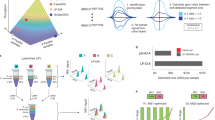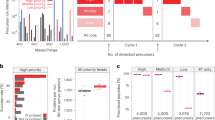Abstract
Although mass spectrometry has become a powerful tool for the functional analysis of biological systems, complete proteome characterization cannot yet be achieved. Instead, the sheer complexity of living organisms demands fractionation of cellular extracts to enable more targeted analyses. Here, we introduce the concept of 'fluorous proteomics,' whereby specific peptide subsets from samples of biological origin are tagged with perfluorinated moieties and subsequently enriched by solid-phase extraction over a fluorous-functionalized stationary phase. This approach is extremely selective, yet can readily be tailored to enrich different subsets of peptides. Additionally, this methodology overcomes many of the limitations of traditional bioaffinity-based enrichment strategies, while enabling new affinity enrichment schemes impossible to implement with bioaffinity reagents. The potential of this methodology is demonstrated by the facile enrichment of peptides bearing particular side-chain functionalities or post-translational modifications from tryptic digests of individual proteins as well as whole cell lysates.
This is a preview of subscription content, access via your institution
Access options
Subscribe to this journal
Receive 12 print issues and online access
$209.00 per year
only $17.42 per issue
Buy this article
- Purchase on Springer Link
- Instant access to full article PDF
Prices may be subject to local taxes which are calculated during checkout




Similar content being viewed by others
References
Gygi, S.P. et al. Quantitative analysis of complex protein mixtures using isotope-coded affinity tags. Nat. Biotechnol. 17, 994–999 (1999).
Shen, M. et al. Isolation and isotope labeling of cysteine- and methionine-containing tryptic peptides: application to the study of cell surface proteolysis. Mol. Cell Proteomics 2, 315–324 (2003).
Zhou, H., Watts, J.D. & Aebersold, R. A systematic approach to the analysis of protein phosphorylation. Nat. Biotechnol. 19, 375–378 (2001).
Oda, Y., Nagasu, T. & Chait, B.T. Enrichment analysis of phosphorylated proteins as a tool for probing the phosphoproteome. Nat. Biotechnol. 19, 379–382 (2001).
Ficarro, S.B. et al. Phosphoproteome analysis by mass spectrometry and its application to Saccharomyces cerevisiae. Nat. Biotechnol. 20, 301–305 (2002).
Posewitz, M.C. & Tempst, P. Immobilized gallium(III) affinity chromatography of phosphopeptides. Anal. Chem. 71, 2883–2892 (1999).
Wells, L. et al. Mapping sites of O-GlcNAc modification using affinity tags for serine and threonine post-translational modifications. Mol. Cell Proteomics 1, 791–804 (2002).
Zhang, H., Li, X.J., Martin, D.B. & Aebersold, R. Identification and quantification of N-linked glycoproteins using hydrazide chemistry, stable isotope labeling and mass spectrometry. Nat. Biotechnol. 21, 660–666 (2003).
Nilsson, C.L. Lectins: proteins that interpret the sugar code. Anal. Chem. 75, 348A–353A (2003).
Trester-Zedlitz, M. et al. A modular cross-linking approach for exploring protein interactions. J. Am. Chem. Soc. 125, 2416–2425 (2003).
Campbell, D.A. & Szardenings, A.K. Functional profiling of the proteome with affinity labels. Curr. Opin. Chem. Biol. 7, 296–303 (2003).
Steen, H. & Mann, M. A new derivatization strategy for the analysis of phosphopeptides by precursor ion scanning in positive ion mode. J. Am. Soc. Mass Spec. 13, 996–1003 (2002).
Rabai, J. & Horvath, T. Facile catalyst separation without water: Fluorous biphase hydroformylation of olefins. Science 266, 72–75 (1994).
Curran, D.P. & Luo, Z. Fluorous synthesis with fewer fluorines (light fluorous synthesis): separation of tagged from untagged products by solid-phase extraction with fluorous reverse-phase silica gel. J. Am. Chem. Soc. 121, 9069–9072 (1999).
Curran, D.a.L., Zhiyong Fluorous techniques for the synthesis and separation of organic molecules. Green Chem. 3, G3–G7 (2001).
Nakamura, Y., Takeuchi, S., Ohgo, Y. & Curran, D.P. Asymmetric alkylation of aromatic aldehydes with diethylzinc catalyzed by a fluorous BINOL-Ti complex in an organic and fluorous biophase system. Tetrahedron Lett. 41, 57–60 (2000).
Kainz, S., Luo, Z., Curran, D.P. & Leitner, W. Synthesis of perfluoroalkyl-substituted aryl bromides and their purification over fluorous reverse phase silica. Synthesis 10, 1425–1427 (1998).
Luo, Z., Zhang, Q., Oderaotoshi, Y. & Curran, D.P. Fluorous mixture synthesis: a fluorous-tagging strategy for the synthesis and separation of mixtures of organic compounds. Science 291, 1766–1769 (2001).
de Visser, P.C. et al. A novel, base-labile fluorous amine protecting group: synthesis and use as a tag in the purification of synthetic peptides. Tetrahedron Lett. 44, 9013–9016 (2003).
Miura, T., Goto, K., Hosaka, D. & Inazu, T. Oligosaccharide synthesis on a fluorous support. Angew. Chem. Int. Ed. 42, 2047–2051 (2003).
Meyer, H.E., Hoffmann-Posorske, E., Korte, H. & Heilmeyer, L.M. Jr. Sequence analysis of phosphoserine-containing peptides. Modification for picomolar sensitivity. FEBS Lett. 204, 61–66 (1986).
Byford, M.F. Rapid and selective modification of phosphoserine residues catalysed by Ba2+ ions for their detection during peptide microsequencing. Biochem. J. 280 (Pt 1), 261–265 (1991).
McLachlin, D.T. & Chait, B.T. Improved beta-elimination-based affinity purification strategy for enrichment of phosphopeptides. Anal. Chem. 75, 6826–6836 (2003).
Khidekel, N., Ficarro, S.B., Peters, E.C. & Hsieh-Wilson, L.C. Exploring the O-GlcNAc proteome: direct identification of O-GlcNAc-modified proteins from the brain. Proc. Natl. Acad. Sci. USA 101, 13132–13137 (2004).
Curran, D.P. Fluorous reverse phase silica gel. A new tool for preparative separations in synthetic organic and organofluorine chemistry. Synlett (9), 1488–1496 (2001).
Hale, J.E., Butler, J.P., Knierman, M.D. & Becker, G.W. Increased sensitivity of tryptic peptide detection by MALDI-TOF mass spectrometry is achieved by conversion of lysine to homoarginine. Anal. Biochem. 287, 110–117 (2000).
Peters, E.C., Horn, D.M., Tully, D.C. & Brock, A. A novel multifunctional labeling reagent for enhanced protein characterization with mass spectrometry. Rapid Commun. Mass Spectrom. 15, 2387–2392 (2001).
Peng, J. et al. A proteomics approach to understanding protein ubiquitination. Nat. Biotechnol. 21, 921–926 (2003).
Chen, X., Chen, Y.H. & Anderson, V.E. Protein cross-links: universal isolation and characterization by isotopic derivatization and electrospray ionization mass spectrometry. Anal. Biochem. 273, 192–203 (1999).
Salomon, A.R. et al. Profiling of tyrosine phosphorylation pathways in human cells using mass spectrometry. Proc. Natl. Acad. Sci. USA 100, 443–448 (2003).
Author information
Authors and Affiliations
Corresponding author
Ethics declarations
Competing interests
The authors declare no competing financial interests.
Supplementary information
Supplementary Fig. 1
Recovery of a fluorous-labeled synthetic peptide from a complex mixture by FSPE (PDF 197 kb)
Supplementary Fig. 2
MASCOT search results (PDF 51 kb)
Supplementary Fig. 3
MS/MS spectrum of doubly charged SLHTLFGDELcF17K (PDF 62 kb)
Supplementary Fig. 4
MS/MS spectrum of doubly charged QLsF17SGVSEIR. (PDF 22 kb)
Supplementary Fig. 5
MS/MS spectrum of doubly charged F17VTQHFAK. (PDF 26 kb)
Supplementary Table 1
Peptide sequences with localized sites of modification. (PDF 12 kb)
Supplementary Table 2
Peptide sequences with candidate phosphorylation sites. (PDF 13 kb)
Rights and permissions
About this article
Cite this article
Brittain, S., Ficarro, S., Brock, A. et al. Enrichment and analysis of peptide subsets using fluorous affinity tags and mass spectrometry. Nat Biotechnol 23, 463–468 (2005). https://doi.org/10.1038/nbt1076
Received:
Accepted:
Published:
Issue Date:
DOI: https://doi.org/10.1038/nbt1076
This article is cited by
-
FAT-switch-based quantitative S-nitrosoproteomics reveals a key role of GSNOR1 in regulating ER functions
Nature Communications (2023)
-
New insights into perfluorinated adsorbents for analytical and bioanalytical applications
Analytical and Bioanalytical Chemistry (2015)
-
A fluorinated dendrimer achieves excellent gene transfection efficacy at extremely low nitrogen to phosphorus ratios
Nature Communications (2014)



